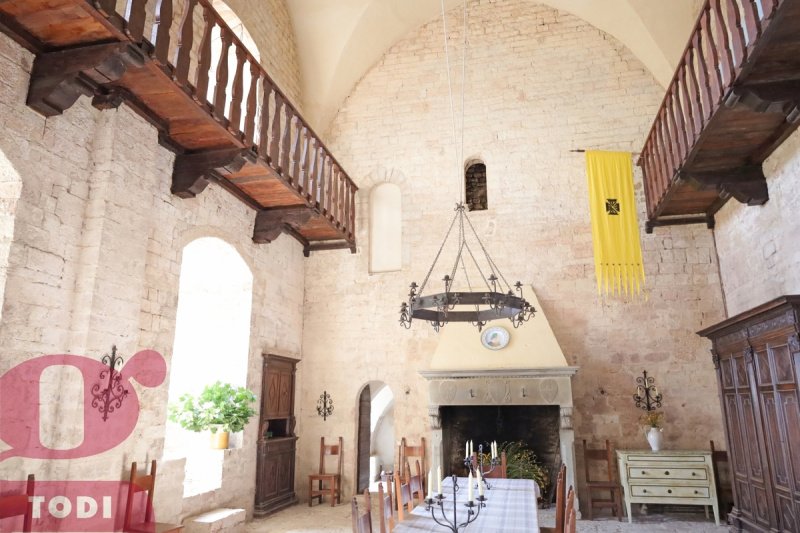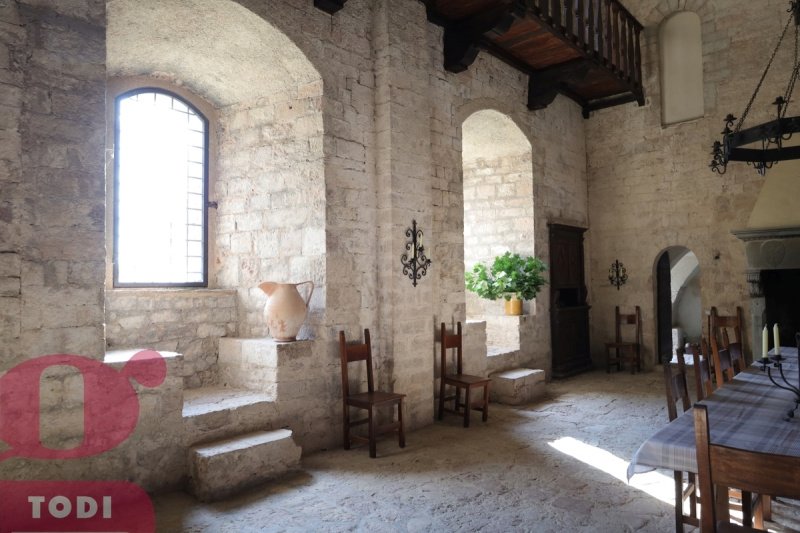1,280,000 €
3 bedrooms historic house, 260 m² Massa Martana, Perugia (province)
Main Features
garden
cellar
Description
Exclusive and unique PROPERTY situated in a historical context in pure nature. Beautiful restored ancient ABBEY with annexed small chapel and STONE HOUSE, a true REFUGE situated in the green heart of Umbria surrounded by over 575 acres (230 Ha) of private WOODS and PASTURE. For lovers of a reserved and intact natural environment, for lovers of silence and tranquillity.
The Martani Mountains divide Umbria from north to south, creating the watershed amid the Valley of the Tiber and the Valley of Spoleto. Considered a “land in between” this very remarkable part of Umbria recalls the atmosphere and the legends of past times, of all the people who might have lived here or just passed through.
At the very top of these mountains, on a plateau over 1000 meters altitude is found the Benedictine Abbey of San Pietro. The ancient structure is set on a mountainside of natural beauty and great charm, overlooking wide fields of billowing grass, ancient woods and forests, century old trees and breath taking panoramas of most beautiful Umbria.
The site is surrounded by meadows, a high forest and four giant beech trees, each between 450 and 500 year’s old.
The complex is accessible by private roadway of 3.5km and the property extends over 575 acres spread over the western slope of the mountain rising from 600 to 1,100 mt. The summit offers a breathtaking view of both sides (Tiber valley with the cities of Perugia, Todi and Orvieto and valley of the Flaminia way with the cities of Assisi, Montefalco, Trevi, Spello, Spoleto and Foligno).
Built before the year 1000 and erected atop the remains of a Roman Temple, the venerable monastery was an important strategic site and permitted total control of the mountain passes.
The whole abbey is very old (9th century) and was destroyed several times. Foundations, emerging here and there, still mark its former perimeter. The first restoration has been undertaken before the First World War. The property was a summer residence for many generations before consolidating the structures and upgrading the facilities in 2005.
The Chapel (Old Sacristy) is consecrated while the church acts as a huge party room. There is a toilet / sink and a bathroom with bathtub.
The stonehouse next door has three bedrooms, a living room, kitchen, toilet / sink and a bathroom with bathtub.
Facilities include running water in both buildings (water), electricity (generator / wind / photovoltaic), heating (cast iron radiators with buried liquid gas container).
The Great Hall of the Abbey, with its gothic vaults, the Florentine Renaissance fireplace and the lofty minstrel gallery is a structure of soaring beauty and architectural purity.
On the ground floor, a twelve-foot-high grey sandstone fireplace occupied the site where the altar probably once stood. In the sacristy, which was converted to a family chapel, you find a funerary stele of a Roman girl named Massellia, entrusted to the gods of the underworld at twenty-one, the same slab (not anything unusual in late-medieval churches) used by the monks as the base of the original altar.
Next to the ABBEY, at a properly servile distance and leaning against the hill, you find the STONE HOUSE initially built with leftover stones for San Pietro’s guardian and now tastefully restored offering refuge and ambience for a life surrounded by the beauty of nature.
At the summit of San Pietro there is a long, treeless pasture inhabited by horses and flocks of sheep. From there the vista sweeps across Umbria’s eastern valley, with a view of the line of cities dotting the ridge of the Apennines from south to north: Spoleto, Trevi, Montefalco, Foligno, Spello, Assisi. Here grow three enormous beech trees, in their own right landmarks of Umbria, able to be singled out and identified from as far away as Todi.
As easy as it is from here to locate Todi, no more than a dozen miles away as the crow flies, with the bell tower of San Fortunato pointing at the sky like a sharp pencil, even the distant glimmering of Perugia, or the very top of the Duomo of Orvieto, from beyond the grey gorge of the Tiber.
Electricity has only recently arrived at San Pietro—in the form of a windmill and a multitude of cleverly concealed storage batteries.
All services are within easy reach of 6 km and the motorway with access to modern life is only 11 km away.
Distances: Todi (22km), Montefalco (31km), Foligno (38km), Terni (38km), Spoleto (40km; ), Assisi (56km), Orvieto (66km), Perugia (68km), Roma (128km’), Firenze (216km)
Airport Perugia San Francesco (68km), Airport Roma Ciampino (142km), Airport Roma Fiumicino (155km)
The Martani Mountains divide Umbria from north to south, creating the watershed amid the Valley of the Tiber and the Valley of Spoleto. Considered a “land in between” this very remarkable part of Umbria recalls the atmosphere and the legends of past times, of all the people who might have lived here or just passed through.
At the very top of these mountains, on a plateau over 1000 meters altitude is found the Benedictine Abbey of San Pietro. The ancient structure is set on a mountainside of natural beauty and great charm, overlooking wide fields of billowing grass, ancient woods and forests, century old trees and breath taking panoramas of most beautiful Umbria.
The site is surrounded by meadows, a high forest and four giant beech trees, each between 450 and 500 year’s old.
The complex is accessible by private roadway of 3.5km and the property extends over 575 acres spread over the western slope of the mountain rising from 600 to 1,100 mt. The summit offers a breathtaking view of both sides (Tiber valley with the cities of Perugia, Todi and Orvieto and valley of the Flaminia way with the cities of Assisi, Montefalco, Trevi, Spello, Spoleto and Foligno).
Built before the year 1000 and erected atop the remains of a Roman Temple, the venerable monastery was an important strategic site and permitted total control of the mountain passes.
The whole abbey is very old (9th century) and was destroyed several times. Foundations, emerging here and there, still mark its former perimeter. The first restoration has been undertaken before the First World War. The property was a summer residence for many generations before consolidating the structures and upgrading the facilities in 2005.
The Chapel (Old Sacristy) is consecrated while the church acts as a huge party room. There is a toilet / sink and a bathroom with bathtub.
The stonehouse next door has three bedrooms, a living room, kitchen, toilet / sink and a bathroom with bathtub.
Facilities include running water in both buildings (water), electricity (generator / wind / photovoltaic), heating (cast iron radiators with buried liquid gas container).
The Great Hall of the Abbey, with its gothic vaults, the Florentine Renaissance fireplace and the lofty minstrel gallery is a structure of soaring beauty and architectural purity.
On the ground floor, a twelve-foot-high grey sandstone fireplace occupied the site where the altar probably once stood. In the sacristy, which was converted to a family chapel, you find a funerary stele of a Roman girl named Massellia, entrusted to the gods of the underworld at twenty-one, the same slab (not anything unusual in late-medieval churches) used by the monks as the base of the original altar.
Next to the ABBEY, at a properly servile distance and leaning against the hill, you find the STONE HOUSE initially built with leftover stones for San Pietro’s guardian and now tastefully restored offering refuge and ambience for a life surrounded by the beauty of nature.
At the summit of San Pietro there is a long, treeless pasture inhabited by horses and flocks of sheep. From there the vista sweeps across Umbria’s eastern valley, with a view of the line of cities dotting the ridge of the Apennines from south to north: Spoleto, Trevi, Montefalco, Foligno, Spello, Assisi. Here grow three enormous beech trees, in their own right landmarks of Umbria, able to be singled out and identified from as far away as Todi.
As easy as it is from here to locate Todi, no more than a dozen miles away as the crow flies, with the bell tower of San Fortunato pointing at the sky like a sharp pencil, even the distant glimmering of Perugia, or the very top of the Duomo of Orvieto, from beyond the grey gorge of the Tiber.
Electricity has only recently arrived at San Pietro—in the form of a windmill and a multitude of cleverly concealed storage batteries.
All services are within easy reach of 6 km and the motorway with access to modern life is only 11 km away.
Distances: Todi (22km), Montefalco (31km), Foligno (38km), Terni (38km), Spoleto (40km; ), Assisi (56km), Orvieto (66km), Perugia (68km), Roma (128km’), Firenze (216km)
Airport Perugia San Francesco (68km), Airport Roma Ciampino (142km), Airport Roma Fiumicino (155km)
Details
- Property TypeHistoric house
- ConditionCompletely restored/Habitable
- Living area260 m²
- Bedrooms3
- Bathrooms3
- Land232 ha
- Garden2,000 m²
- Energy Efficiency Rating333
- ReferenceFC103
Distance from:
Distances are calculated in a straight line
- Airports
- Public transport
- Highway exit34.0 km
- Hospital14.5 km - Ospedale San Matteo degli Infermi
- Coast92.6 km
- Ski resort44.9 km
What’s around this property
- Shops
- Eating out
- Sports activities
- Schools
- Pharmacy2.8 km - Pharmacy - Farmacia Paolucci
- Veterinary14.7 km - Veterinary
Information about Massa Martana
- Elevation351 m a.s.l.
- Total area78.41 km²
- LandformInland hill
- Population3642
What do you think of this advert’s quality?
Help us improve your Gate-away experience by giving a feedback about this advert.
Please, do not consider the property itself, but only the quality of how it is presented.


